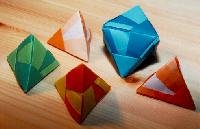Triangular Faced Origami Polyhedra |
||||
|
Folding a unit from a square Putting together two units Making a tetrahedron Making an octahedron Making an icosahedron Other examples Home |

|
Introduction I designed this unit with Kazuyo Inoue, while at Queen's University, in Spring 1997. It can be used to make various polyhedra with triangular faces, such as the octahedron to the right, or the tetrahedra to the left, and many more, shown below. There are two versions, one from A4 paper (which will also work from other size rectangles), and the other from square paper. Click on any photo on this page to see a larger version. |

|
|












































